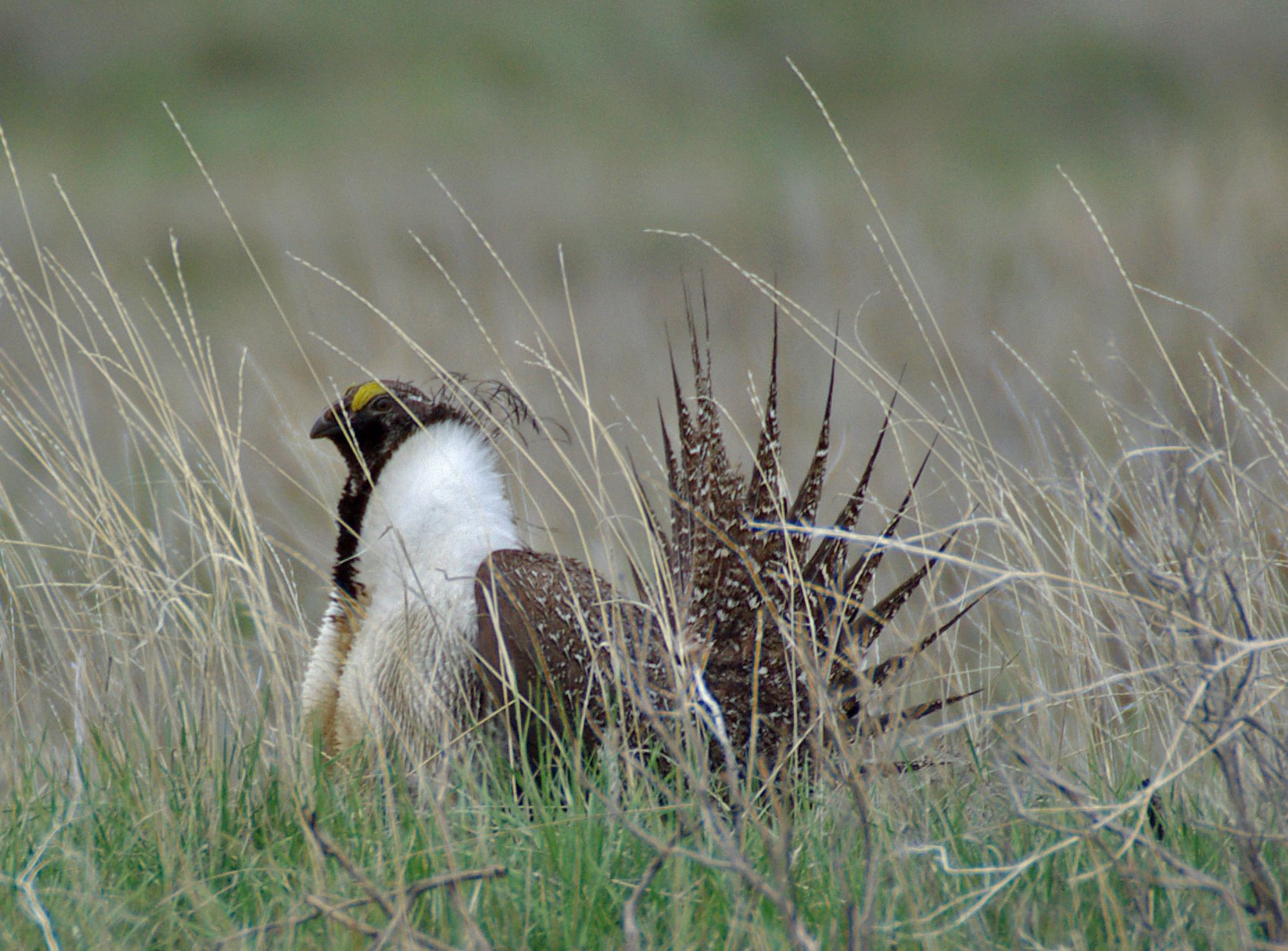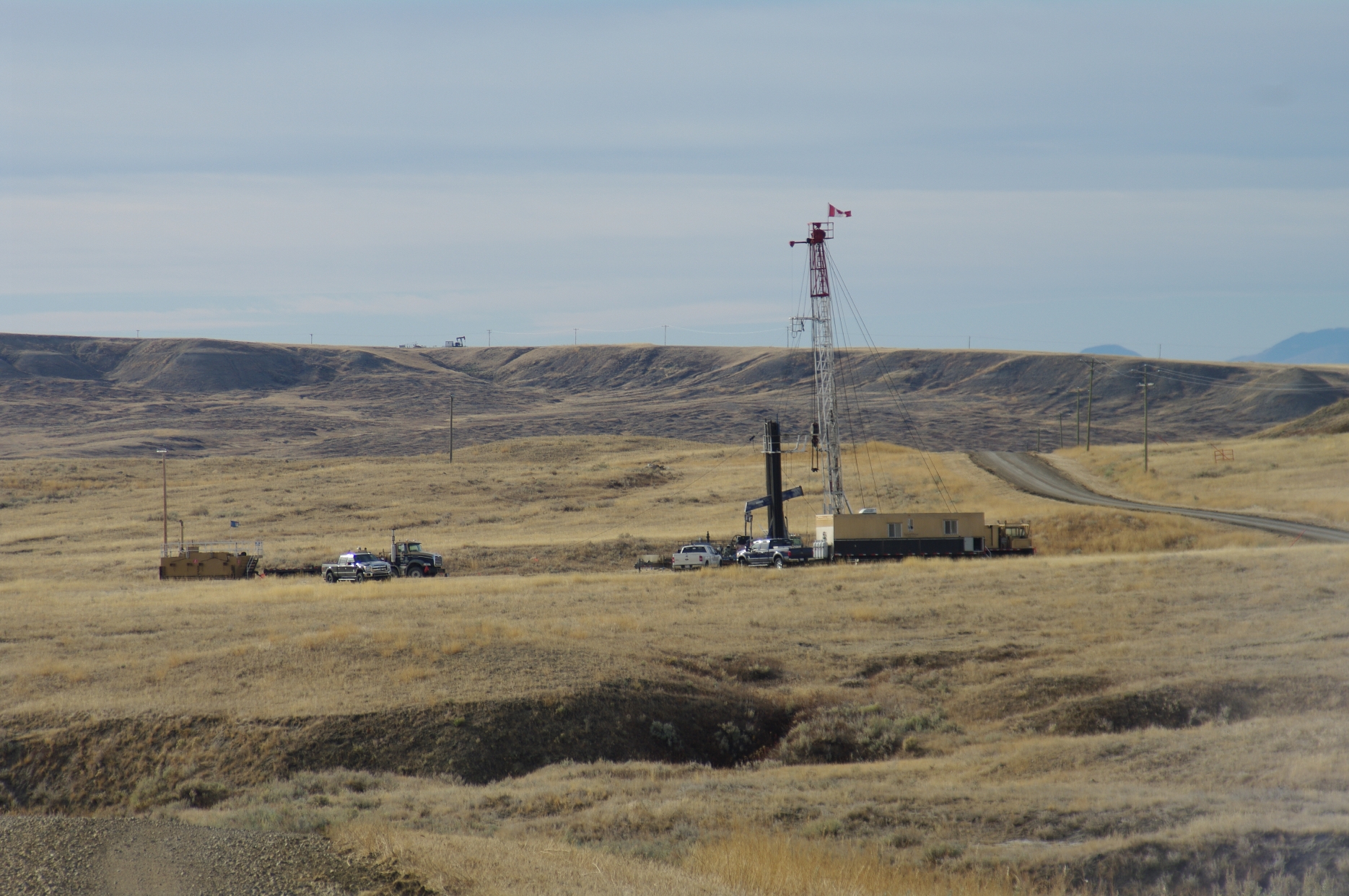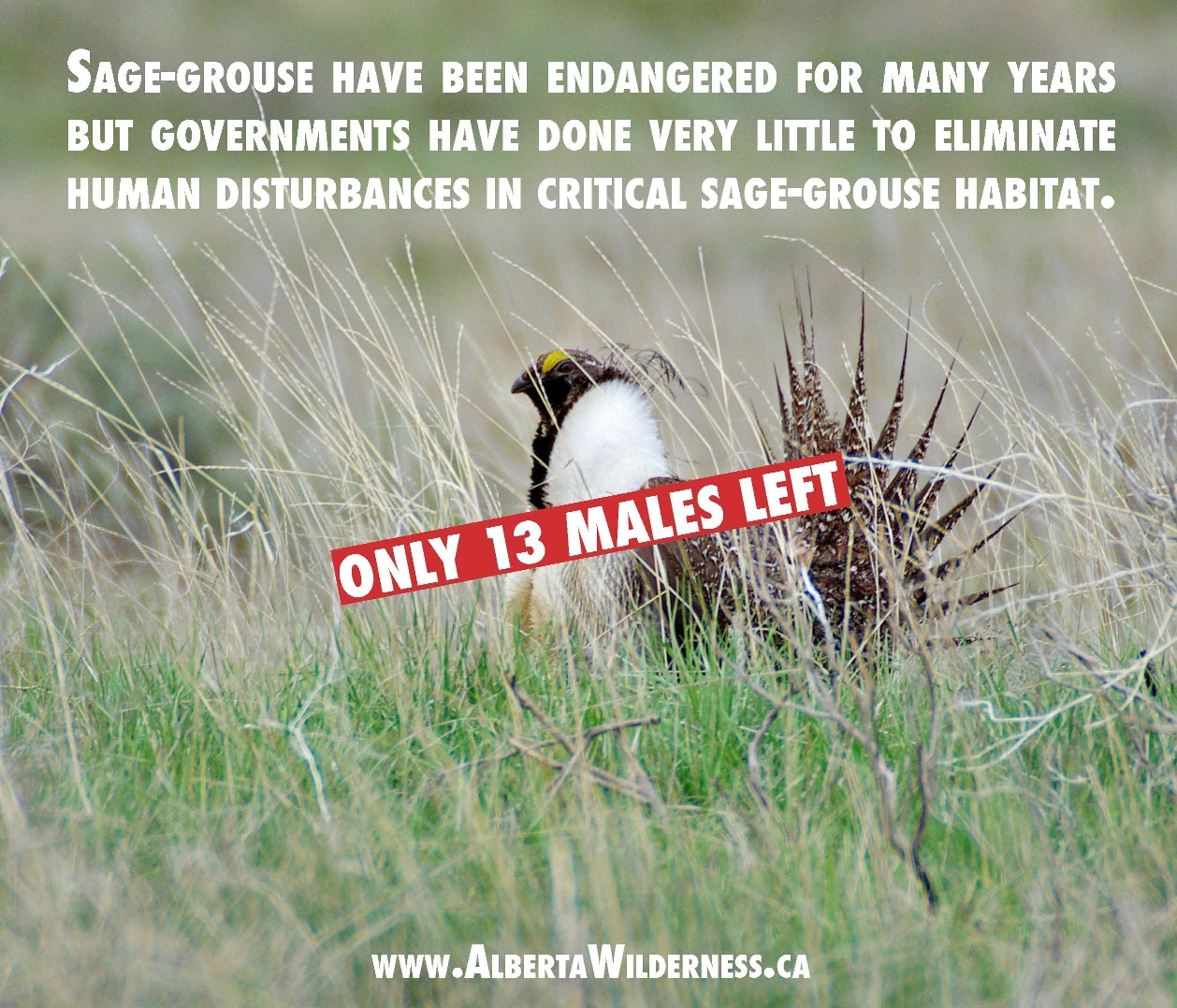Guest Post by Madeline Wilson of the Alberta Wilderness Association
Spring appears to be arriving a little early in Alberta this year, and as the snow begins to melt (well I guess the snow never really came this year, did it?), prairie birders will begin to head out in the early mornings with the hope of witnessing the impressive courtship dances of our prairie grouse. The charismatic Greater sage-grouse (Centrocercus urophasianus ) is recognized among naturalists for many reasons, but is perhaps best known for the spectacular courtship displays that occur on mating grounds (lek sites) each spring.
The greater sage-grouse is the largest of all North American grouse, and both males and females camouflage well in prairie grasses thanks to finely marked brown, black, and white feathers. Male sage-grouse can be distinguished by the presence of an arched yellow comb above the eye, long feathers behind the back of the neck, and a large white breast patch within which two large air sacs are concealed. The survival of the sage-grouse is intrinsically reliant upon the presence and abundance of silver sagebrush (Artemisia cana) flats, found in the Dry Mixedgrass subregion of the Grasslands natural region. This succulent shrub provides the bird’s food, shelter and cover from predators.
Each year, usually beginning in late March, hopeful male sage-grouse head to traditional lek sites where they may spend up to several weeks displaying for female hens. During this lively and intricate performance, males inflate and compress their air sacs producing loud popping sounds. This auditory experience, combined with the stunning visual of raised tail feathers and majestic strutting is indeed one to remember- or so I hear that is. And unfortunately, hearing tales and watching videos may be as close as many Albertans ever get to experiencing sage-grouse mating displays first hand.
Throughout the last decade, the reputation of the sage-grouse has grown for reasons besides being the Casanova of Alberta’s grasslands; the greater sage-grouse is also the most endangered species in Alberta. The sage-grouse was designated an At Riskspecies in Alberta in 1996 (downgraded to Endangered in 2000), and was recognized by the Committee on the Status of Endangered Wildlife in Canada (COSEWIC) as a federally Endangered species in 1998. Yet, it is now 2012 and neither provincial nor federal governments have taken any meaningful action to protect the sage-grouse or the habitat upon which its survival depends. Last spring, only 13 male sage-grouse were recorded on leks in Alberta. In neighbouring Saskatchewan, the only other Canadian province in which sage-grouse exist, populations are only slightly higher. These dismal counts represent an almost 90 percent population decline in Canada between 1988 and 2006.
It is clear that, like with most threatened and endangered species worldwide, this rapid decline can be attributed to habitat destruction and fragmentation. Degradation of native grasslands in southern Alberta due to urban expansion, cultivation, livestock grazing, and oil and gas exploration have left only approximately 43% of our grasslands remaining. Although 70% of the species at risk in the province reside in the grasslands, less than 1% is currently protected. In Alberta, sage-grouse can now be found only in the extreme southeast corner of the province, primarily surrounding the town of Manyberries, Alberta.
Sage-grouse are notoriously sensitive to disturbance, and studies have shown that, when confronted with oil and gas development, sage-grouse will abandon or avoid leks essential to their survival. Extensive energy development in southern Alberta has essentially impacted all remaining sage-grouse habitat.
Currently provincial species at risk are, sloppily, handled under the Alberta Wildlife Act. This piece of legislation does not require any mandatory actions to protect species at risk, besides the production of a provincial recovery plan. Since the Alberta Greater Sage-Grouse Recovery Plan was produced in 2005, populations have only continued to plummet. In light of this, we are relying upon provisions within the federal Species at Risk Act (SARA) that state the federal Environment Minister has a mandatory duty to make recommendations to protect a species facing imminent threat of extinction. The environmental law group Ecojustice is currently representing Alberta Wilderness Association (AWA), and several other conservation groups as we pursue legal action against Environment Minister Peter Kent over his continued failure to protect Canada’s endangered greater sage-grouse. In order to prevent the imminent extinction of this prairie icon, the critical habitat necessary to sage-grouse survival and recovery must be protected through legislation. Sage-grouse require a buffer of at least 1.9 km around all nesting, brood-rearing and winter habitat, and a 6.4 km buffer around all lek sites. Within this buffer zone all industrial activity must be prohibited, and existing industrial infrastructure must be removed.
Perhaps the single most frustrating, but also encouraging, piece of the sage-grouse puzzle is that the bird’s ecology and habitat requirements are well-understood. If we want to recover healthy sage-grouse populations in Alberta, it is entirely possible. But what we are obviously still missing is the desire and the political will to take the necessary steps before it is too late.
So I hope to leave you not with a bleak perspective on the state of species at risk in Alberta, but with an awareness of a truly remarkable species, and the desire to seek action from both federal and provincial levels of government to ensure the native grasslands of southern Alberta have not witnessed the sage-grouse’s last dance. For more information on what you can do to help protect sage-grouse, please visit www.albertawilderness.ca
-Madeline Wilson, AWA conservation specialist






Canadians and scientists have been shouting about this issue for years. Unfortunately none of the politicos give a damn until an issue makes big headlines, which usually means it’t too late by then.
I can’t believe this situation has been allowed to become so critical. Are Canadians so unaware of their birth right, and it sure in hell isn’t oil?